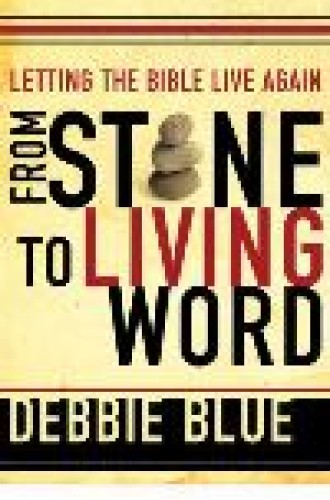From Stone to Living Word: Letting theBible LiveAgain
Sometimes funny, frequently irreverent and consistently thoughtful, Debbie Blue, a founding pastor of the House of Mercy in St. Paul, Minnesota, presents a solid introduction to a method of reading scripture that invites ongoing investigation of basic theological concepts and questions.
Blue grew up in a conservative Baptist congregation that clung tightly to the concept that the Bible is a solid rock in a world filled with shifting sand. They clung so tightly, Blue suggests, that they closed themselves off from the living God toward whom the Bible points and withdrew into the apparent safety of idolizing the Bible itself. “Nietzsche accused theologians and philosophers and the church of killing and stuffing whatever they worshiped,” Blue writes. It’s a common, almost unavoidable mistake made by many more people than just the members of her childhood congregation. She deftly calls on theologians Karl Barth and James Alison and philosophers Bruce Benson and Jean-Luc Marion as she tells how idolatry keeps popping up in her own life and faith.
Rather than idolizing the Bible, Blue honors scripture as a witness to the actions and intentions of the living God, who lives without the boundaries of death. The Bible points toward but does not contain or limit God or God’s deep desire for relationship. Well aware of some of the odder corners of the Bible, such as Elisha’s curse against tormenting young boys (2 Kings 2:23-24) that results in their being mauled by bears, Blue chooses to embrace the rich and messy complexity of Bible stories as a call into relationship with God rather than a list of pat answers to life’s problems.
Blue turns to Jewish midrashic tradition as a fruitful antidote to thinking that scripture has one, singular voice, one truth. “Western Christian interpretation has often feared incoherence and multiplicity,” Blue writes. “Perhaps that fear has caused us to ignore some of the text’s lush and equivocal, unruly and boisterous qualities.” She follows the lead of Avivah Gottlieb Zornberg in claiming that the midrashic tradition embraces multiple interpretations, that the tradition is a process of engagement between the reader, the text and the divine Other toward whom the text points.
Blue then presents her own midrashim—informal and inviting explorations of scripture that call on her own experiences as a wife, a mother and a preacher to uncover God’s unrelenting desire and love for us, God’s beloved. Writing about the dry bones called back into life in Ezekiel, Blue asserts that “if we live really by the grace of God, depending on God’s mercy, then if God withdraws, there is no more life. What we proclaim in the church is that God doesn’t withdraw, ever. Even when we’re bone.”
In another midrash Blue turns to the encounter between Mary and Elizabeth to explore the physical reality of incarnation. “If you’ve ever grown a baby in your womb and birthed it, you might have an idea of what it means to say that God became incarnate in this manner,” writes Blue. The incarnation involves all the messy bits of birth and human life. Blue notes that we might prefer a God who pulls us out of this worldly mess, but instead we get a God who shows up smack dab in the middle of all of it right alongside us.
From Stone to Living Word is the work of a serious observer of scripture at earnest play. Blue does not plunge in alone but takes with her the works of other theologians, philosophers and observers of the human/sacred encounter. While her work is inviting to readers just beginning to ask serious questions about God and God’s intentions toward humanity, it is not a dumbed-down, just-the-highlights introduction to theology. It is intended to shake up readers, just as Blue is shaken up whenever she encounters the text that points toward, rather than encloses, the “radically alive, relentlessly loving, having-nothing-to-do-with-death God.”






